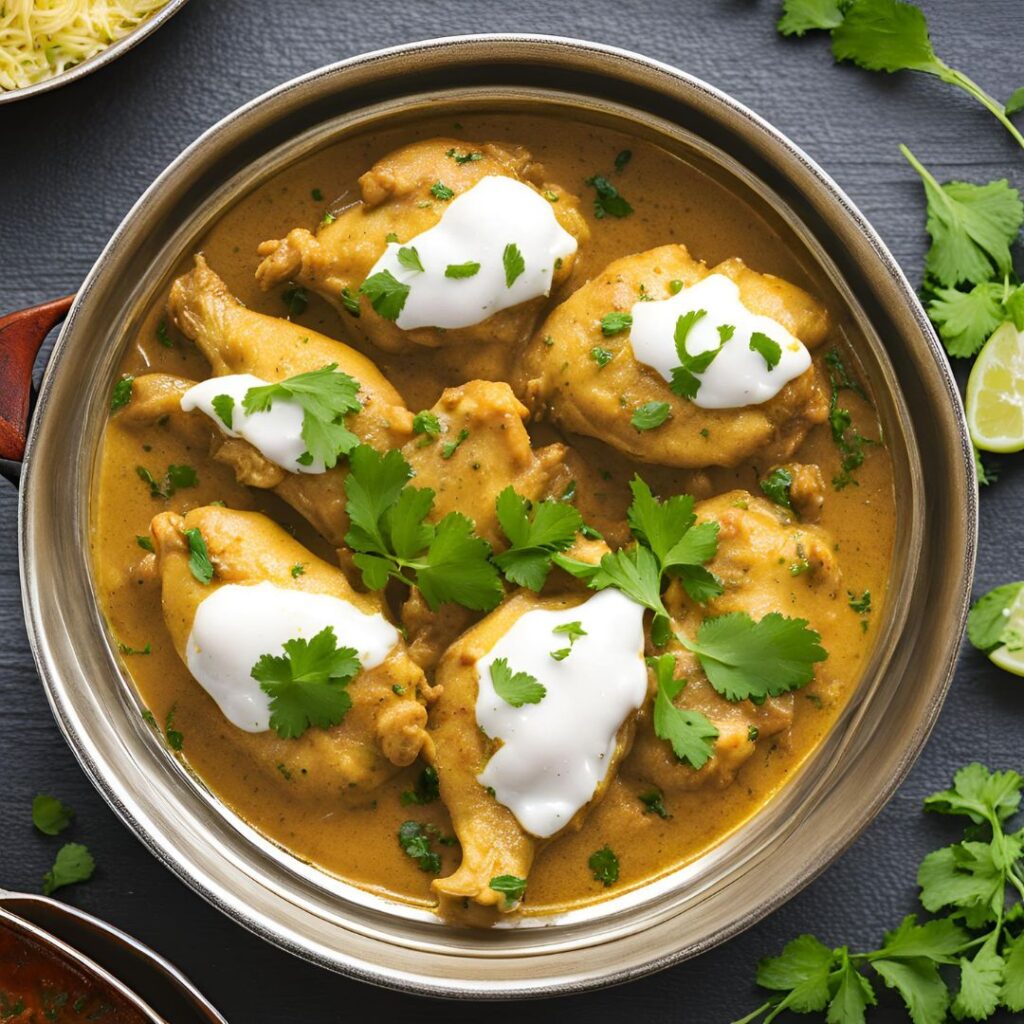

Dahi Chicken Recipe: A Flavorful Indian Culinary Classic. Indian cuisine, known for its diversity and depth of flavor, features an array of dishes that span a wide spectrum of tastes. From fiery curries to rich biryanis, the subcontinent's culinary traditions offer something for every palate. Among the most beloved and comforting of Indian dishes is Dahi Chicken, a mouthwatering chicken curry that combines the richness of yogurt with an aromatic blend of spices. This dish is a perfect reflection of the harmonious balance of flavors that define Indian cooking, where each ingredient plays a vital role in creating an unforgettable taste experience.
Dahi Chicken, also known as Yogurt Chicken, is a dish that enjoys popularity across various regions of India, each with its unique twist. It’s a dish that has stood the test of time, delighting generations of food lovers with its creamy texture, tender chicken, and the perfect balance of tangy, spicy, and savory notes. This dish is a prime example of how yogurt, a staple ingredient in many Indian kitchens, can transform a simple chicken curry into a rich, luxurious meal that is as comforting as it is satisfying.
Before diving into the specifics of Dahi Chicken, it's important to understand the role that yogurt plays in Indian cooking. Yogurt, or dahi, is much more than just a cooling agent or side dish in Indian cuisine; it is an integral part of many traditional recipes. Its versatility allows it to be used in marinades, curries, and even desserts. In the case of Dahi Chicken, yogurt not only imparts a subtle tang but also acts as a tenderizer, making the chicken incredibly soft and juicy.
The use of yogurt in Indian cooking is centuries old, and it continues to be an essential component in various dishes, especially curries. The lactic acid in yogurt helps to break down the protein in meats like chicken, making them more tender. Additionally, yogurt adds a rich creaminess to the dish without being as heavy as cream or coconut milk. Its slight tang complements the bold spices commonly used in Indian cooking, providing a balanced flavor profile that is neither too overpowering nor too bland.
Dahi Chicken likely has its origins in North India, where yogurt-based gravies and marinades are commonly used to prepare dishes like chicken, lamb, and goat meat. The dish may have evolved from the wider tradition of yogurt and spice-based cooking that dates back to ancient India. One of the earliest forms of yogurt-based meat dishes can be traced back to Mughal times, when rich, complex gravies became popular in royal kitchens.
The Mughal influence on Indian cuisine is undeniable, and many iconic dishes, including Dahi Chicken, were born out of the fusion of Persian and Indian culinary traditions. The Mughals were known for their love of lavish meals, and their kitchens were filled with spices, dried fruits, nuts, and dairy products. Dahi Chicken, like many Mughlai dishes, reflects this opulent use of ingredients and techniques. The spices in Dahi Chicken, such as garam masala, cumin, coriander, and turmeric, are staples of Indian cooking, while the yogurt serves as a perfect base for creating the dish's signature creamy texture.
Although Dahi Chicken likely began as a North Indian dish, its widespread appeal has led to its incorporation into the menus of restaurants and homes across the country. Each region has developed its own interpretation of the dish, adjusting the spice levels and ingredients to suit local preferences. For example, in some regions, Dahi Chicken is cooked with the addition of coconut milk or cashews, lending a sweet undertone to the curry. In other regions, it might be made spicier with the use of green chilies or red chili powder. This adaptability and regional variation are part of what makes Dahi Chicken such a beloved and enduring dish.
One of the standout features of Dahi Chicken is its use of a carefully selected blend of spices. These spices not only add depth and warmth to the dish but also serve as a hallmark of Indian cuisine. The combination of ground coriander, cumin, garam masala, and other aromatic spices gives Dahi Chicken its characteristic flavor profile: warm, earthy, and subtly fragrant, with a slight heat that lingers on the palate.
Garam masala, a quintessential spice blend used in many Indian curries, is an essential component of Dahi Chicken. Made from a combination of cinnamon, cardamom, cloves, and cumin, garam masala adds warmth and complexity to the dish. The spices in the garam masala are carefully balanced to create a blend that complements the richness of the yogurt and the tenderness of the chicken. As the chicken simmers in the yogurt-based gravy, the spices release their natural oils, infusing the meat and sauce with their distinctive flavors.
Other spices, such as turmeric and red chili powder, contribute their unique color and heat to the dish. Turmeric, in particular, is often used for its earthy, slightly bitter flavor, as well as its vibrant golden color. When combined with yogurt, turmeric imparts a lovely hue to the dish and adds to its overall depth of flavor.
While the core of Dahi Chicken remains the same—chicken simmered in a yogurt-based gravy with an aromatic blend of spices—there are countless regional adaptations of the dish. In Punjab, for instance, the dish might be cooked with a dollop of fresh cream to give it an extra richness, while in Southern India, the addition of coconut milk might create a slightly sweeter, milder version of the curry.
In urban centers like Delhi and Mumbai, Dahi Chicken has become a popular choice for both home cooks and restaurant-goers. Many restaurants serve Dahi Chicken with a choice of bread (such as naan or paratha) or steamed rice. The dish’s versatility makes it perfect for a variety of occasions—from casual family dinners to festive celebrations. The balance of spices, the tender chicken, and the rich, creamy gravy make it a favorite in Indian households, and it often makes an appearance during special occasions like weddings, festivals, and family gatherings.
Beyond its delicious taste, Dahi Chicken also offers a range of health benefits. Yogurt, a key ingredient in the dish, is known for its probiotic properties, which support gut health. It is also a good source of calcium, protein, and vitamins, making Dahi Chicken a nourishing choice. The use of fresh chicken provides high-quality lean protein, which is important for muscle building and overall health.
Spices like cumin and coriander are often used in traditional medicine for their digestive and anti-inflammatory properties. Turmeric, another key ingredient in Dahi Chicken, has long been prized for its anti-inflammatory and antioxidant properties, which contribute to overall health and well-being. When combined with the health benefits of yogurt, Dahi Chicken becomes not just a delicious dish but a wholesome meal that nourishes the body.
Dahi Chicken is more than just a meal; it is an experience—a journey of flavors and textures that tantalizes the senses. The combination of tender chicken, creamy yogurt, and aromatic spices creates a dish that is both comforting and indulgent. Whether you’re a seasoned cook or someone just beginning to explore Indian cuisine, Dahi Chicken is a dish that is relatively easy to prepare and sure to impress anyone at the table.
Its ability to be adapted to suit individual preferences—whether you like it mild or spicy, rich or light—only adds to its appeal. Whether you're serving it for a family dinner, a special occasion, or just craving something delicious, Dahi Chicken is a dish that will leave everyone asking for seconds.
So, the next time you're looking to explore the depths of Indian cuisine or want to add something special to your meal repertoire, make sure to try Dahi Chicken. Its unforgettable taste and versatility will undoubtedly make it a dish you return to again and again.
Dahi Chicken stands as one of the best examples of how yogurt can elevate a simple chicken dish into something truly extraordinary. With its roots deeply embedded in Indian culinary history, it brings together a rich blend of spices, tender chicken, and the unmistakable tang of yogurt to create a meal that is satisfying, nutritious, and bursting with flavor. No matter where you are in the world, Dahi Chicken is a dish that transcends borders, uniting people through its shared love for good food and vibrant flavors. Whether you're new to Indian cuisine or a lifelong fan, Dahi Chicken promises an unforgettable dining experience.
This recipe serves 4 people.
The beauty of Dahi Chicken lies in the harmonious blend of spices that create a flavorful gravy without overwhelming the dish. Avoid over-spicing the curry—it should be aromatic but not too fiery. Here's how to balance the spices effectively:
If you're uncertain, always start with smaller amounts of each spice, tasting as you go. You can add more, but you can't take it out once it's in!
Yes, you can use boneless chicken if you prefer. Boneless chicken breasts or thighs will cook faster and absorb the marinade more easily. However, many people prefer using bone-in chicken for Dahi Chicken because the bones add more flavor and help retain moisture, making the dish juicier. If you use boneless chicken, the cooking time will be shorter.
Yogurt is the key ingredient in this dish, giving it its signature creaminess and tang. However, if you're looking for an alternative, you can use Greek yogurt (which is thicker) or sour cream for a richer taste. For a dairy-free option, coconut yogurt or cashew cream might work, though it will change the flavor profile of the dish.
Curdling can occur when the yogurt is exposed to high heat or added too quickly into the curry. To prevent this:
Following these steps will keep the yogurt smooth and creamy.
Marinating the chicken is crucial for flavor and tenderness. Ideally, marinate the chicken for at least 1 hour to allow the spices to penetrate the meat. However, for best results, marinate the chicken for 4-6 hours or even overnight in the refrigerator. The longer the chicken marinates, the more flavorful and tender it will be.
Yes, Dahi Chicken can be made in advance and stored in the refrigerator for up to 2 days. In fact, the flavors tend to deepen and improve the next day, making it an excellent dish for meal prepping or preparing for a gathering. Reheat the curry gently on low heat to avoid curdling the yogurt.
Absolutely! Dahi Chicken can be customized to your spice level. You can add more green chilies, red chili powder, or even use a hotter variety of chili powder. If you prefer a milder version, simply reduce the amount of chili powder or use mild paprika instead.
For extra heat, you can also add a pinch of crushed red pepper flakes or chili paste to the gravy while cooking.
Dahi Chicken pairs beautifully with a variety of sides. The most popular options are:
Yes, you can add vegetables if you want to make the dish more hearty or include some extra nutrition. Vegetables like potatoes, carrots, orbell peppers can be added along with the chicken. Simply sauté them along with the onions and tomatoes before adding the marinated chicken.
If your Dahi Chicken has a thinner gravy than you'd like, there are a few ways to thicken it:
Yes, you can freeze Dahi Chicken. After cooking, allow it to cool completely, and then transfer it to an airtight container or freezer bag. It can be stored in the freezer for up to 2-3 months. When you're ready to eat it, defrost it in the refrigerator overnight and reheat it gently on the stovetop, adding a little water if necessary to adjust the consistency.
Enjoy the yum :)